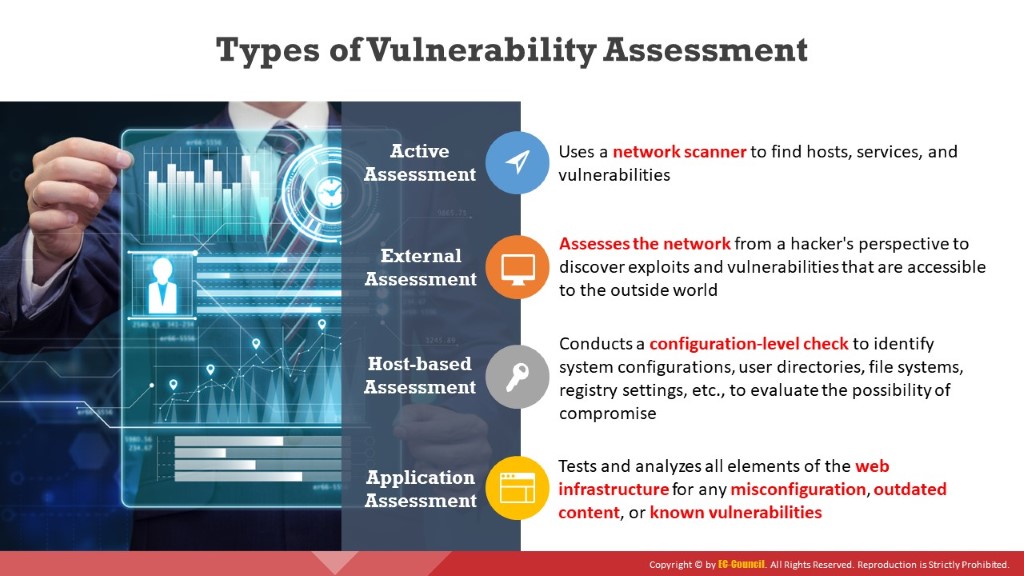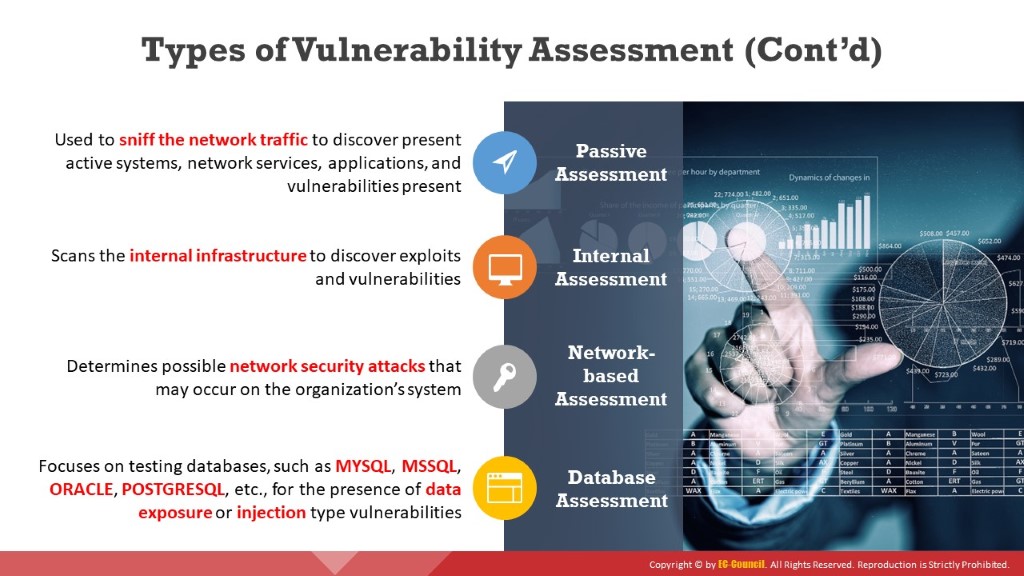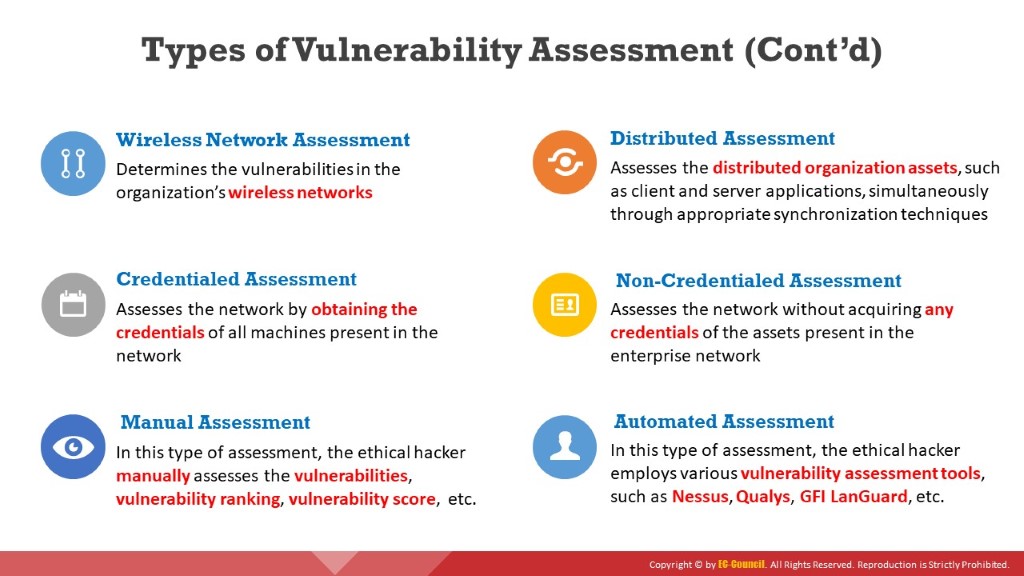


Given below are the different types of vulnerability assessments:
Active Assessment
A type of vulnerability assessment that uses network scanners to identify the hosts, services, and vulnerabilities present in a network. Active network scanners can reduce the intrusiveness of the checks they perform.
Passive Assessment
Passive assessments sniff the traffic present on the network to identify the active systems, network services, applications, and vulnerabilities. Passive assessments also provide a list of the users who are currently accessing the network.
External Assessment
External assessment examines the network from a hacker’s point of view to identify exploits and vulnerabilities accessible to the outside world. These types of assessments use external devices such as firewalls, routers, and servers. An external assessment estimates the threat of network security attacks from outside the organization. It determines the level of security of the external network and firewall.
The following are some of the possible steps in performing an external assessment:
Determine a set of rules for firewall and router configurations for the external network
Check whether the external server devices and network devices are mapped
Identify open ports and related services on the external network
Examine the patch levels on the server and external network devices
Review detection systems such as IDS, firewalls, and application-layer protection systems
Get information on DNS zones
Scan the external network through a variety of proprietary tools available on the Internet
Examine Web applications such as e-commerce and shopping cart software for vulnerabilities
Internal Assessment
An internal assessment involves scrutinizing the internal network to find exploits and vulnerabilities. The following are some of the possible steps in performing an internal assessment:
Specify the open ports and related services on network devices, servers, and systems
Check the router configurations and firewall rule sets
List the internal vulnerabilities of the operating system and server
Scan for any trojans that may be present in the internal environment
Check the patch levels on the organization’s internal network devices, servers, and systems
Check for the existence of malware, spyware, and virus activity and document them
Evaluate the physical security
Identify and review the remote management process and events
Assess the file-sharing mechanisms (for example, NFS and SMB/CIFS shares)
Examine the antivirus implementation and events
Host-based Assessment
Host-based assessments are a type of security check that involve conducting a configuration-level check to identify system configurations, user directories, file systems, registry settings, and other parameters to evaluate the possibility of compromise. These assessments check the security of a particular network or server. Host-based scanners assess systems to identify vulnerabilities such as native configuration tables, incorrect registry or file permissions, and software configuration errors. Host-based assessments use many commercial and open-source scanning tools.
Network-based Assessment
Network assessments determine the possible network security attacks that may occur on an organization’s system. These assessments discover network resources and map the ports and services running to various areas on the network. It evaluates the organization’s system for vulnerabilities such as missing patches, unnecessary services, weak authentication, and weak encryption. Network assessment professionals use firewalls and network scanners, such as Nessus. These scanners identify open ports, recognize the services running on those ports, and detect vulnerabilities associated with these services. These assessments help organizations identify points of entry and attack into a network since they follow the path and approach of the hacker. They help organizations determine how systems are vulnerable to Internet and intranet attacks, and how an attacker can gain access to important information. A typical network assessment conducts the following tests on a network:
Checks the network topologies for inappropriate firewall configuration
Examines the router filtering rules
Identifies inappropriately configured database servers
Tests individual services and protocols such as HTTP, SNMP, and FTP
Reviews HTML source code for unnecessary information
Performs bounds checking on variables
Application Assessment
An application assessment focuses on transactional web applications, traditional client-server applications, and hybrid systems. It analyzes all elements of an application infrastructure, including deployment and communication within the client and server. This type of assessment tests the webserver infrastructure for any misconfiguration, outdated content, or known vulnerabilities. Security professionals use both commercial and open-source tools to perform such assessments.
Database Assessment
A database assessment is any assessment focused on testing the databases for the presence of any misconfiguration or known vulnerabilities. These assessments mainly concentrate on testing various database technologies like MYSQL, MSSQL, ORACLE, and POSTGRESQL to identify data exposure or injection type vulnerabilities. Security professionals use both commercial and open-source tools to perform such assessments.
Wireless Network Assessment
Wireless network assessment determines the vulnerabilities in an organization’s wireless networks. In the past, wireless networks used weak and defective data encryption mechanisms. Now, wireless network standards have evolved, but many networks still use weak and outdated security mechanisms and are open to attack. Wireless network assessments try to attack wireless authentication mechanisms and gain unauthorized access. This type of assessment tests wireless networks and identifies rogue networks that may exist within an organization’s perimeter. These assessments audit client-specified sites with a wireless network. They sniff wireless network traffic and try to crack encryption keys. Auditors test other network access if they gain access to the wireless network.
Distributed Assessment
This type of assessment, employed by organizations that possess assets like servers and clients at different locations, involves simultaneously assessing the distributed organization assets, such as client and server applications, using appropriate synchronization techniques. Synchronization plays a critical role in this type of assessment. By synchronizing the test runs together, all the separate assets situated at multiple locations can be tested at the same time.
Credentialed Assessment
Credentialed assessment is also called authenticated assessment. In this type of assessment, the security professional possesses the credentials of all machines present in the assessed network. The chances of finding vulnerabilities related to operating systems and applications are higher in credential assessment than in non-credential assessment. This type of assessment is challenging since it is highly unclear who owns particular assets in large enterprises, and even when the security professional identifies the actual owners of the assets, accessing the credentials of these assets is highly tricky since the asset owners generally do not share such confidential information. Also, even if the security professional successfully acquires all required credentials, maintaining the password list is a huge task since there can be issues with things like changed passwords, typing errors, and administrative privileges. Although it is the best way of assessing a target enterprise network for vulnerabilities and is highly reliable, it is a complex assessment that is challenging.
Non-Credentialed Assessment
Non-credentialed assessment, also called unauthenticated assessment, provides a quick overview of weaknesses by analyzing the network services that are exposed by the host. Since it is a non-credential assessment, a security professional does not require any credentials for the assets to perform their assessments. This type of assessment generates a brief report regarding vulnerabilities; however, it is not reliable because it does not provide deeper insight into the OS and application vulnerabilities that are not exposed by the host to the network. This assessment is also incapable of detecting the vulnerabilities that are potentially covered by firewalls. It is prone to false-positive outputs and is not reliably effective as compared to credential-based assessment.
Manual Assessment
After performing footprinting and network scanning and obtaining crucial information, if the security professional performs manual research for exploring the vulnerabilities or weaknesses, they manually rank the vulnerabilities and score them by referring to vulnerability scoring standards like CVSS and vulnerability databases like CVE and CWE. Such assessment is considered to be manual.
Automated Assessment
An assessment where a security professional uses vulnerability assessment tools such as Nessus, Qualys, or GFI LanGuard to perform a vulnerability assessment of the target is called an automated assessment. Unlike manual assessments, in this type of assessment, the security professional does not perform footprinting and network scanning. They employ automated tools that can perform all such activities and are also capable of identifying weaknesses and CVSS scores, acquiring critical CVE/CWE information related to the vulnerability, and suggesting remediation strategies.